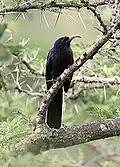Scimitarbill
Scimitarbills (also spelt scimitar-bills) are three species of African bird belonging to the genus Rhinopomastus. They are often classified in the woodhoopoe family, Phoeniculidae; however, genetic studies show that they diverged from the true woodhoopoes about 10 million years ago and so they are sometimes placed in a family of their own, the Rhinopomastidae.[2][3]
| Scimitarbills | |
|---|---|
| Common scimitarbill (Rhinopomastus cyanomelas) | |
| Scientific classification | |
| Domain: | Eukaryota |
| Kingdom: | Animalia |
| Phylum: | Chordata |
| Clade: | Dinosauria |
| Class: | Aves |
| Order: | Bucerotiformes |
| Family: | Phoeniculidae |
| Genus: | Rhinopomastus Jardine, 1828 |
| Type species | |
| Rhinopomastus smithii[1] Jardine, 1828 | |
| Species | |
They are smaller than most woodhoopoes and their bills are strongly curved like a scimitar, giving them their name. They are mostly glossy black in colour with a few white markings on the wings. While other woodhoopoes are gregarious birds which gather in flocks, the scimitarbills are usually seen alone or in pairs.
They feed mainly on insects and other invertebrates, which they find by using their bills to probe into holes and crevices. They are acrobatic birds, well-adapted for clambering through trees. The eggs are laid in a tree cavity.
Species
| Image | Scientific name | Common Name | Description | Distribution |
|---|---|---|---|---|
.jpg.webp) | Rhinopomastus aterrimus | Black scimitarbill | less markedly curved bill than the others | Two populations, one extending from West Africa eastwards to Ethiopia and the other in Angola and adjacent countries. |
.jpg.webp) | Rhinopomastus cyanomelas | Common scimitarbill | the largest and longest-tailed species and the only one with white markings on the tail. | Southern and Eastern Africa |
 | Rhinopomastus minor | Abyssinian scimitarbill | smaller than the others with a red bill rather than a black one. | arid scrub from Tanzania north to Somalia. |
References
- "Picidae". aviansystematics.org. The Trust for Avian Systematics. Retrieved 2023-07-26.
- Fjeldsa, Jon; Bowie, Rauri C. K. (2008). "New perspectives on the origin and diversification of Africa's forest avifauna". African Journal of Ecology. 46 (3): 235–247. doi:10.1111/j.1365-2028.2008.00992.x.
- Symes, Craig; Perrin, Michael R. (2008). "The habitat and associated bird assemblages of the Grey-headed Parrot Poicephalus fuscicollis suahelicus in Limpopo Province, South Africa". Ostrich - Journal of African Ornithology. 79 (1): 9–22. doi:10.2989/OSTRICH.2008.79.1.2.375.
Bibliography
- Christopher Perrins, ed. (2004) The New Encyclopedia of Birds, Oxford University Press, Oxford
- Ian Sinclair & Peter Ryan (2003) Birds of Africa south of the Sahara, Struik, Cape Town